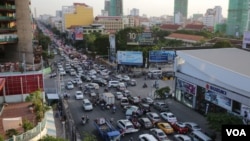The backgrounds of garment worker transport trucks are to be put under the microscope in a government initiative aimed at stymieing reckless driving, officials have said.
Interior Minister Sar Kheng said last week that his office would work with the Ministry of Transportation and National Police to create a database of drivers to increase accountability.
“[Drivers] must have a brief background in the system, managed by the Ministry of Transportation and the General Commissariat of the National Police,” Kheng said.
He added that road deaths had been high in recent years due to speeding and drivers disobeying the law.
In 2016, some 271 fewer deaths were recorded on Cambodia’s roads, a 14 percent drop on the previous year, when 2,265 people were killed and about 15,000 people injured.
In May 2015, 19 garment workers in Svay Rieng province were killed in a deadly crash with a tourist bus that made international headlines.
The ministry said while the death toll so far this year was also seeing a downward trend, March was a particularly deadly month on Cambodia’s roads.
Lieutenant General Run Rathveasna, director of the police’s public order department, said the force had been working on a driver database since the start of the year and had already collected brief biographies on more than 200 truck drivers, allowing background checks to take place.
“If we have their biography. It is easy for us to find out what companies they are working for and when they leave from one company to another,” he said.
Ear Chariya, a road safety expert, said while it was a good first step to create the database, officials must ensure that all of the garment worker transport drivers have a proper license.
“All the transport companies must have an internal rulebook in managing the drivers and their vehicles,” he said.
According to Handicap International, traffic accidents in Cambodia cost the government about $337 million annually, roughly 3 percent of gross domestic product.
San Chey, executive director of the Affiliated Network for Social Accountability Cambodia, said he doubted whether many of the garment worker drivers had passed a test before taking to the roads.
“I think it is good to have all the drivers to do the driving capacity test again, since we have doubts,” he said, adding that some drivers are told to speed by their employers.







